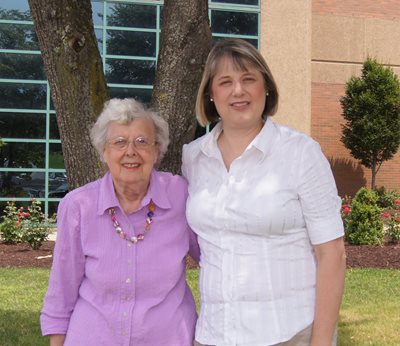MORGANTOWN, W.Va. – When WVU Healthcare Stroke Coordinator Martha Power, C-F.N.P., saw the next patient in the Ruby Memorial Hospital Emergency Department (ED), she said, “I know you.”
It was Christine Tall, an 87-year-old resident of the Village at Heritage Point. Tall and Power had met a few weeks earlier at Heritage Point when Power gave a stroke awareness talk. Tall approached Power afterwards to discuss some of her risk factors for stroke – high blood pressure and high cholesterol. Now, Tall was in the ED experiencing stroke symptoms.

It started one morning in June when Tall was having trouble trying to change the ink cartridge on her computer printer.
“I couldn’t think of the word for ink cartridge. Nothing was working, and I was getting very frustrated,” Tall said. “I noticed numbness in my hands, I felt confused, and I was having trouble expressing myself.”
Tall felt like something was wrong, so she walked to the front desk of Heritage Point holding up her arm.
“I wasn’t making any sense, and I couldn’t remember words,” she said. The wellness coordinator at Heritage called 911.
In the ED, a team of doctors and nurses assembled around Tall. They asked her a series of questions like what day and time it was, could she identify what a pen was, or could she identify what a stethoscope was.
“She said, ‘I can’t remember what it is called, but it is used to listen to your heart,’” said her daughter Catherine Tall, who was there with her mother in the ED. Tall has no memory of saying that, and Catherine helped fill in the gaps of information that her mother couldn’t remember.
“It was very good that Martha Power was there because she explained the steps of what was going on, and she was a liaison to the family,” Catherine Tall said.
Power is part of the WVU Stroke Team, which is available 24 hours a day, seven days a week to evaluate and treat a stroke in time to minimize damage. The team is comprised of neurologists, emergency medicine physicians, radiologists, and neurosurgeons.
When a stroke occurs or is suspected, call 911. The 911 operator will contact an emergency medical service to dispatch an ambulance. When the emergency responders examine the stroke victim, they will contact WVU Healthcare with vital patient information. The team begins preparations before patients arrive at the hospital. Patients entering the ED with symptoms of a stroke are rapidly assessed with a trio of tests, including CT scan, angiography, and perfusion, which then guide the choice of treatment. WVU Hospitals is designated a Primary Stroke Center by the Joint Commission on Accreditation of Hospital Organizations.
After a CT scan, the doctors showed Tall and her daughter that a blood clot was located near a language processing area of the brain. They had arrived in the ED within the three to four-and-a-half hour timeframe in which stroke patients can receive a blood clot dissolving drug called tPA, and Tall and her daughter decided that it was the right choice.
“I am very fortunate that things worked out the way that they did. The team in the ED was ready and right on it when we arrived. I am very lucky,” Tall said.
She stayed in the hospital for two days, and tests concluded that the stroke had left no permanent damage, so she was discharged. After a few days, Tall said she felt comfortable enough to get back to her regular routine, including driving, exercising, and caring for herself.
“The stroke education talk played a role in Mrs. Tall coming to get quick stroke care and helped her recognize the stroke symptoms,” Power said. “She didn’t wait it out or lie down when she was feeling unwell. She let the nurse at Heritage know that something was wrong. It is so gratifying and fulfilling to know that education sessions like this can help save peoples’ lives and their quality of life by getting medical attention for stroke symptoms sooner.”
A stroke is a brain attack that cuts off blood flow and oxygen to the brain. Anyone can have a stroke no matter your age, race, or gender. According to the National Stroke Association, approximately 795,000 strokes will occur this year, one every 40 seconds, and will take a life approximately every four minutes.
For more information about the warning signs of stroke and stroke risk factors, visit the National Stroke Association website at www.stroke.org.
Photo identifications: (left to right) Stroke survivor Christine Tall and her daughter Catherine Tall


